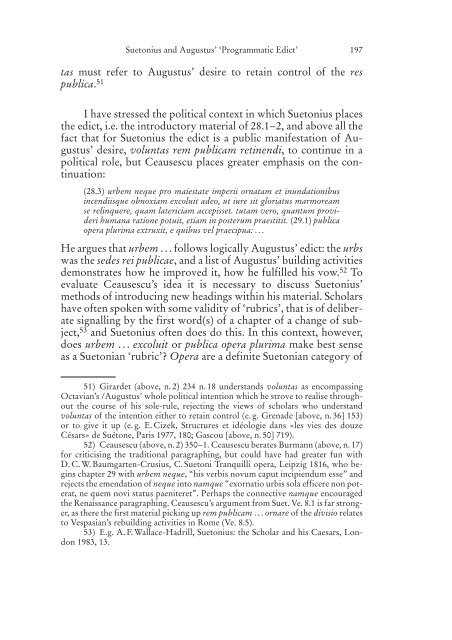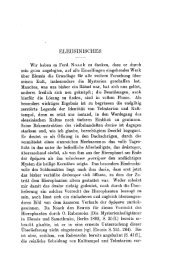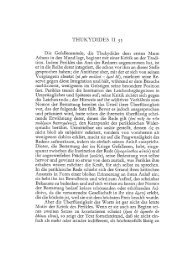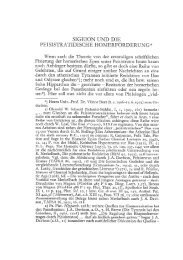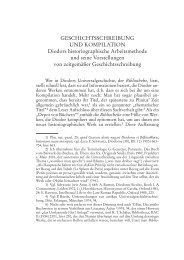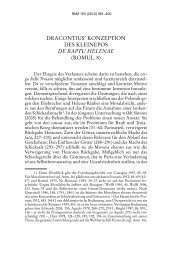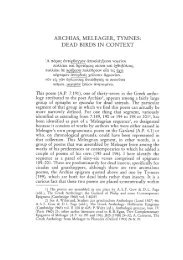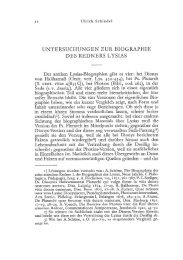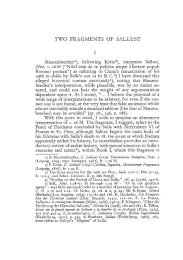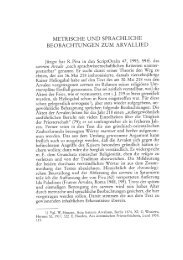VIRGILIO E STESICORO Una ricerca sulla Tabula Iliaca Capitolina *
VIRGILIO E STESICORO Una ricerca sulla Tabula Iliaca Capitolina *
VIRGILIO E STESICORO Una ricerca sulla Tabula Iliaca Capitolina *
Sie wollen auch ein ePaper? Erhöhen Sie die Reichweite Ihrer Titel.
YUMPU macht aus Druck-PDFs automatisch weboptimierte ePaper, die Google liebt.
Suetonius and Augustus’ ‘Programmatic Edict’<br />
tas must refer to Augustus’ desire to retain control of the res<br />
publica. 51<br />
I have stressed the political context in which Suetonius places<br />
the edict, i.e. the introductory material of 28.1–2, and above all the<br />
fact that for Suetonius the edict is a public manifestation of Augustus’<br />
desire, voluntas rem publicam retinendi, to continue in a<br />
political role, but Ceausescu places greater emphasis on the continuation:<br />
(28.3) urbem neque pro maiestate imperii ornatam et inundationibus<br />
incendiisque obnoxiam excoluit adeo, ut iure sit gloriatus marmoream<br />
se relinquere, quam latericiam accepisset. tutam vero, quantum provideri<br />
humana ratione potuit, etiam in posterum praestitit. (29.1) publica<br />
opera plurima extruxit, e quibus vel praecipua: . . .<br />
He argues that urbem ... follows logically Augustus’ edict: the urbs<br />
was the sedes rei publicae, and a list of Augustus’ building activities<br />
demonstrates how he improved it, how he fulfilled his vow. 52 To<br />
evaluate Ceausescu’s idea it is necessary to discuss Suetonius’<br />
methods of introducing new headings within his material. Scholars<br />
have often spoken with some validity of ‘rubrics’, that is of deliberate<br />
signalling by the first word(s) of a chapter of a change of subject,<br />
53 and Suetonius often does do this. In this context, however,<br />
does urbem ... excoluit or publica opera plurima make best sense<br />
as a Suetonian ‘rubric’? Opera are a definite Suetonian category of<br />
51) Girardet (above, n. 2) 234 n. 18 understands voluntas as encompassing<br />
Octavian’s /Augustus’ whole political intention which he strove to realise throughout<br />
the course of his sole-rule, rejecting the views of scholars who understand<br />
voluntas of the intention either to retain control (e. g. Grenade [above, n. 36] 153)<br />
or to give it up (e. g. E. Cizek, Structures et idéologie dans «les vies des douze<br />
Césars» de Suétone, Paris 1977, 180; Gascou [above, n. 50] 719).<br />
52) Ceausescu (above, n. 2) 350–1. Ceausescu berates Burmann (above, n. 17)<br />
for criticising the traditional paragraphing, but could have had greater fun with<br />
D. C. W. Baumgarten-Crusius, C. Suetoni Tranquilli opera, Leipzig 1816, who begins<br />
chapter 29 with urbem neque, “his verbis novum caput incipiendum esse” and<br />
rejects the emendation of neque into namque “exornatio urbis sola efficere non poterat,<br />
ne quem novi status paeniteret”. Perhaps the connective namque encouraged<br />
the Renaissance paragraphing. Ceausescu’s argument from Suet. Ve. 8.1 is far stronger,<br />
as there the first material picking up rem publicam ...ornare of the divisio relates<br />
to Vespasian’s rebuilding activities in Rome (Ve. 8.5).<br />
53) E.g. A. F. Wallace-Hadrill, Suetonius: the Scholar and his Caesars, London<br />
1983, 13.<br />
197


